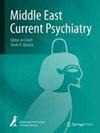Status and sociodemographic correlates of pathological internet use among adolescents in Jordan: a cross-sectional study
IF 1.6
Q3 PSYCHIATRY
引用次数: 0
Abstract
Pathological internet use (PIU) refers to excessive use of the internet and is commonly described using various terms, such as internet addiction disorder (IAD). It is a significant concern for mental health professionals in schools and primary care settings, especially among adolescents. Although in the sphere of psychological assessment, PIU is classified as a behavioral addiction and has been proven to be as serious as substance abuse, PIU is not officially classified as a psychological disorder in the Diagnostic and Statistical Manual of Mental Disorders. The aims of this study were to investigate the PIU status and explore the sociodemographic correlates of PIU among adolescents in Jordan. This study employed a descriptive‒explorative design with a cross-sectional approach. The study participants were 735 adolescents, grades 9th–11th. Data were collected via valid and reliable self-report questionnaire related to the main study variables over a period ranging from the beginning of March to the end of April 2024. For the data analysis, t tests and ANOVAs were used to identify any significant differences in the mean PIU total score in relation to the sociodemographic variables. The results revealed that among the 735 adolescents, 75.8% (n = 557) experienced PIU, with a significant difference in the mean PIU total score across grades (F = 3.37, p < .05) and academic performance levels (F = 8.76, p < .05), but not in terms of sex (t = .371, p > .05), father’s education level (F = .789, p > .05), or family income level (F = 1.076, p > .05). This study provides practical findings that students with poor academic performance and lower grades have higher levels of PIU. It is recommended that an ongoing screening for PIU be conducted to intervene proactively through multidisciplinary collaboration to manage disproportionate internet use among adolescents. Furthermore, this study adequately raises awareness about the far-reaching consequences of PIU for adolescents of both sexes. Finally, the results will be utilized to guide future studies to highlight more sociodemographic correlates of PIU.约旦青少年病理性使用互联网的状况与社会人口学相关因素:一项横断面研究
病理性网络使用(PIU)是指过度使用互联网,通常有多种说法,如网络成瘾症(IAD)。它是学校和基层医疗机构心理健康专业人员关注的一个重要问题,尤其是在青少年中。虽然在心理评估领域,PIU 被归类为行为成瘾,并被证明与药物滥用一样严重,但《精神疾病诊断与统计手册》并未将 PIU 正式归类为心理障碍。本研究旨在调查约旦青少年的 PIU 状况,并探讨 PIU 的社会人口学相关因素。本研究采用了横断面描述性探索设计。研究对象为 735 名九至十一年级的青少年。数据通过有效可靠的自我报告问卷收集,问卷涉及 2024 年 3 月初至 4 月底期间的主要研究变量。数据分析采用了 t 检验和方差分析,以确定 PIU 平均总分与社会人口学变量之间是否存在显著差异。结果显示,在 735 名青少年中,75.8%(n = 557)有 PIU 的经历,不同年级(F = 3.37,p .05)、父亲教育水平(F = .789,p > .05)或家庭收入水平(F = 1.076,p > .05)的 PIU 平均总分差异显著。这项研究提供了切实可行的结论,即学习成绩差和年级较低的学生具有较高的 PIU 水平。建议对 PIU 进行持续筛查,通过多学科合作进行前瞻性干预,以控制青少年过度使用互联网的情况。此外,本研究还充分提高了人们对 PIU 对男女青少年的深远影响的认识。最后,研究结果将用于指导今后的研究,以强调更多与 PIU 相关的社会人口学因素。
本文章由计算机程序翻译,如有差异,请以英文原文为准。
求助全文
约1分钟内获得全文
求助全文
来源期刊

Middle East Current Psychiatry
Medicine-Psychiatry and Mental Health
CiteScore
3.00
自引率
0.00%
发文量
89
审稿时长
9 weeks
 求助内容:
求助内容: 应助结果提醒方式:
应助结果提醒方式:


